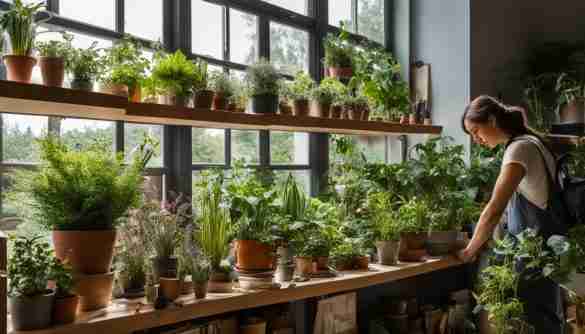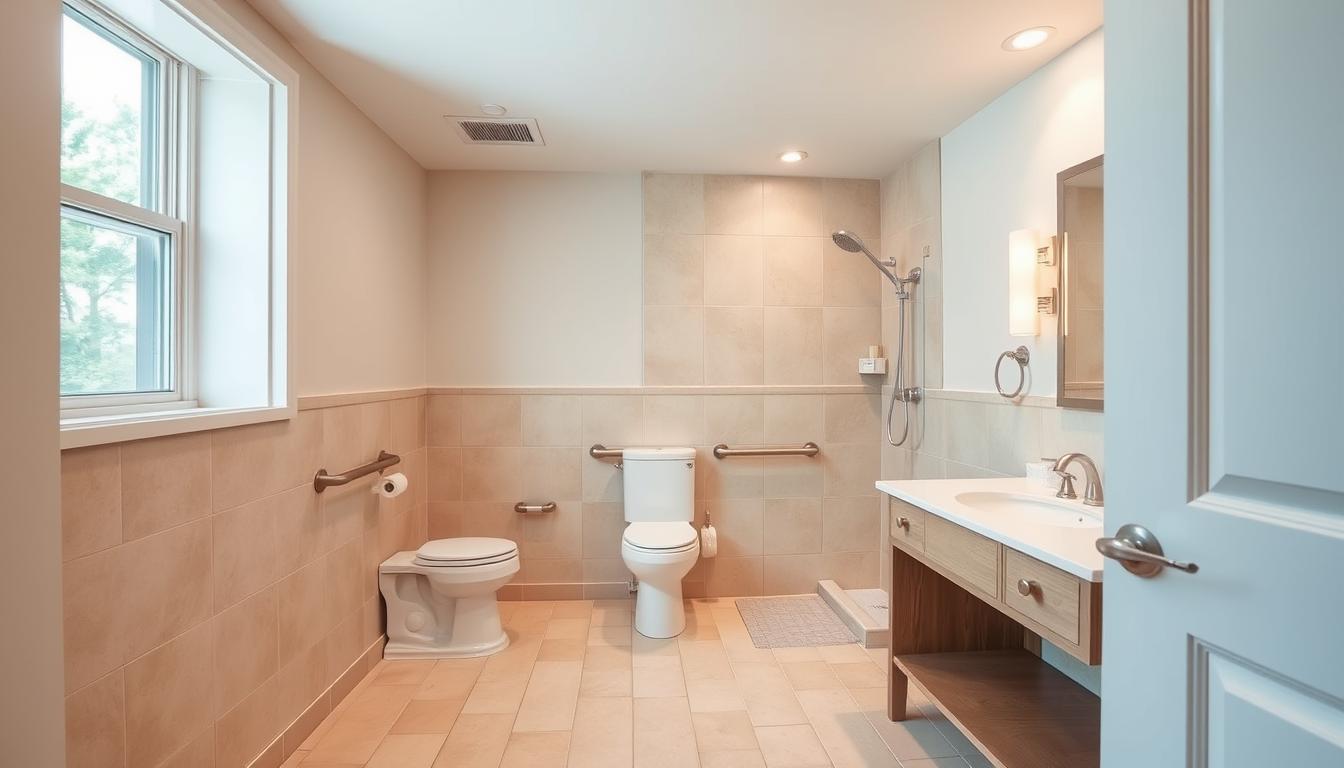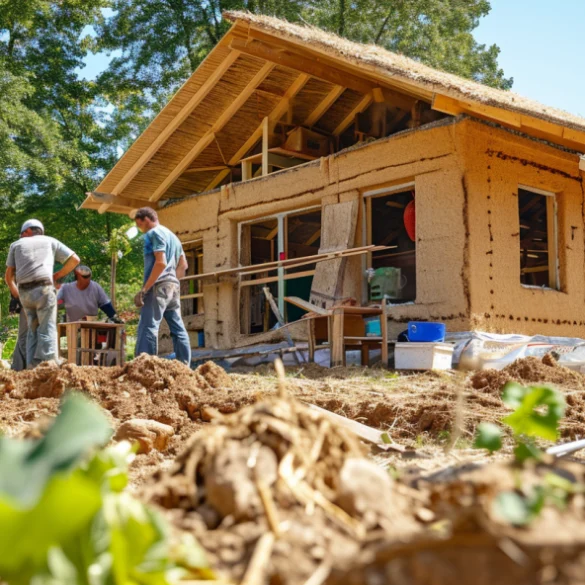Welcome to Sustainable Home Magazine! Discover the world of indoor gardening and unleash the power of air-purifying plants to transform your living space. Indoor gardening is not only a fantastic way to bring the beauty of nature indoors, but it also offers numerous benefits for your health and well-being.
Indoor gardening allows you to create a lush and vibrant environment, even if you have limited access to sunlight. With a wide range of plants that thrive in various light conditions, you can design an indoor garden that suits your style and complements your home decor.
One of the key advantages of indoor gardening is the presence of air-purifying plants. These plants have the remarkable ability to filter out harmful toxins from the air, ensuring a cleaner and healthier indoor environment for you and your loved ones. By eliminating pollutants such as formaldehyde, benzene, and trichloroethylene, air-purifying plants improve the air quality and promote overall well-being.
In this comprehensive guide, we will explore the fascinating world of indoor gardening. From selecting the best air-purifying plants for your indoor garden to providing you with essential care tips, we aim to equip you with the knowledge and inspiration to create a thriving oasis within your home.
Key Takeaways:
- Indoor gardening brings greenery into your living space and offers the benefits of air-purifying plants.
- Air-purifying plants filter out toxins from the air, improving overall air quality and promoting a healthier environment.
- Indoor gardening is suitable for various light conditions, allowing you to create a garden even in low-light areas.
- Choosing the right air-purifying plants is crucial and depends on factors such as available space and maintenance level.
- Indoor gardening offers both physical and mental health benefits, including reduced stress and improved well-being.
The Benefits of Air-Purifying Plants
Air-purifying plants not only beautify your indoor space but also offer a myriad of health benefits. These plants help remove harmful toxins from the air, such as formaldehyde, benzene, and trichloroethylene, which are commonly found in household products and can lead to health issues.
Indoor gardening with air-purifying plants can improve air quality, reduce allergies, enhance sleep quality, and promote relaxation and stress reduction. Additionally, these plants release oxygen and increase humidity, creating a healthier and more comfortable environment.
“Having air-purifying plants in your home is like having your own natural air filtration system. They act as nature’s purifiers, ensuring the air you breathe is clean and fresh.”
The Health Benefits of Air-Purifying Plants
Air-purifying plants have been proven to offer a range of health benefits. Here are some key advantages:
- Improved Air Quality: Air-purifying plants filter out pollutants and toxins, improving the overall air quality in your home.
- Allergy Reduction: These plants can help reduce allergens in the air, providing relief for those with allergies or respiratory conditions.
- Better Sleep: The improved air quality created by air-purifying plants can enhance sleep quality, leading to a more restful night’s sleep.
- Stress Reduction: Indoor gardening and being surrounded by nature has a calming effect, reducing stress and promoting relaxation.
By incorporating air-purifying plants into your indoor environment, you can experience these benefits and create a healthier and more pleasant living space.
Choosing the Right Air-Purifying Plants
When selecting air-purifying plants for your indoor garden, it’s important to consider factors such as the size of your space, the available light conditions, and the level of maintenance you are willing to provide. Here are some popular air-purifying plants to consider:
| Plant | Light Requirements | Maintenance Level |
|---|---|---|
| Aloe Vera | Bright, indirect light | Low |
| Snake Plant | Low to bright light | Low |
| English Ivy | Bright, indirect light | Moderate |
| Peace Lily | Low to bright light | Moderate |
| Bamboo Palm | Bright, indirect light | Low |
These plants have been proven to effectively filter toxins from the air and are relatively easy to care for. Choose plants that suit your space and lifestyle, and enjoy the benefits of cleaner and healthier indoor air.
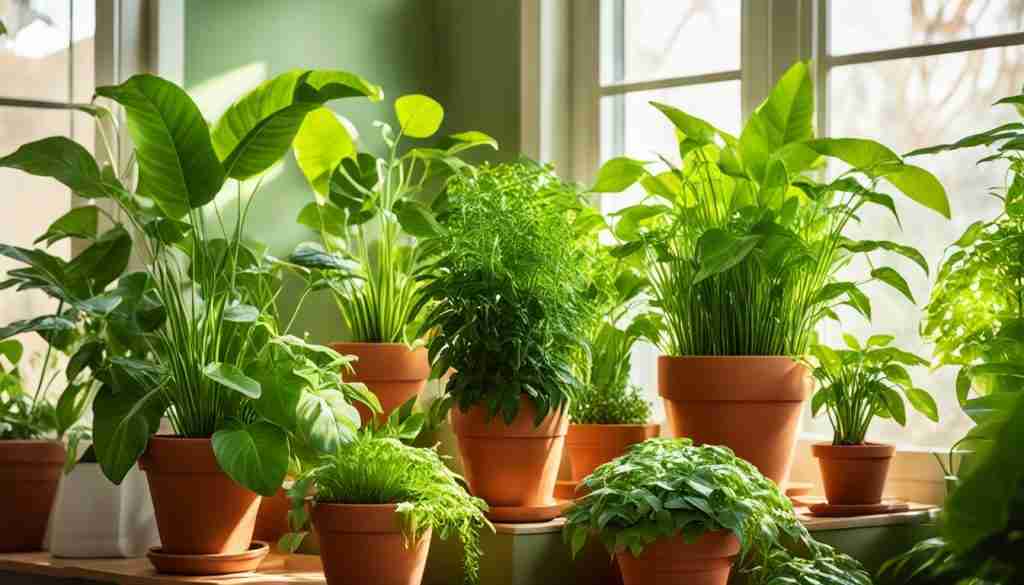
Indoor gardening with air-purifying plants brings both aesthetic beauty and health benefits to your home. By selecting the right plants and creating a suitable environment, you can enjoy improved air quality, reduced allergies, and a more relaxed and comfortable living space.
Choosing the Right Air-Purifying Plants
When it comes to selecting air-purifying plants for your indoor garden, it’s essential to consider various factors to ensure their success. Consider the size of your space, the available light conditions, and the level of maintenance you are willing to provide. By making informed choices, you can create a healthy and thriving indoor garden.
Factors to Consider when Choosing Air-Purifying Plants
- Size of your space: Determine the available space in your home to accommodate the plants. Consider whether you need compact plants for smaller areas or larger plants to fill empty corners.
- Light conditions: Assess the amount of light your indoor space receives. Some plants thrive in bright, indirect light, while others can tolerate low-light conditions. Choose plants that can thrive in your specific lighting situation.
- Maintenance level: Consider the amount of time you can dedicate to plant care. Some plants require regular watering, while others are more forgiving and can tolerate occasional neglect. Choose plants that align with your maintenance abilities.
Best Air-Purifying Plants for Your Indoor Garden
Here are some popular air-purifying plants that can effectively filter toxins from the air and are relatively easy to care for:
| Plant | Benefits |
|---|---|
| Aloe Vera | Removes formaldehyde and benzene; produces oxygen at night |
| Snake Plant | Filters out formaldehyde and benzene; thrives in low light |
| English Ivy | Reduces airborne mold spores and filters out formaldehyde |
| Peace Lily | Purifies the air by removing mold spores, formaldehyde, and trichloroethylene |
| Bamboo Palm | Filters out formaldehyde, benzene, and trichloroethylene |
If you share your living space with pets, it’s important to choose pet-friendly air-purifying plants that are safe for them to be around.

By considering the size of your space, the available light conditions, and your maintenance capabilities, you can select the best air-purifying plants to create a clean and healthy indoor environment. These plants not only filter toxins from the air but also add beauty and tranquility to your home.
Indoor Gardening Tips for Beginners
If you’re new to indoor gardening, here are a few tips to help you get started:
- Choose plants suitable for your available light conditions: Some plants thrive in bright, indirect light, while others can tolerate low-light environments. Assess the lighting in your space and select plants accordingly.
- Provide proper watering and humidity: Overwatering or underwatering can harm your plants. Research the watering needs of each plant and create a watering schedule. Additionally, monitor humidity levels and adjust as necessary.
- Consider organic fertilizers: Use organic fertilizers to nourish your plants and promote healthy growth. Avoid chemical-laden fertilizers that can harm both your plants and the environment.
- Experiment and have fun: Indoor gardening is a rewarding and relaxing hobby. Don’t be afraid to try new plants, explore different arrangements, and enjoy the process of connecting with nature.
Remember, starting an indoor garden requires patience and learning. With time and experience, you’ll develop a green thumb and create a thriving oasis in your home.
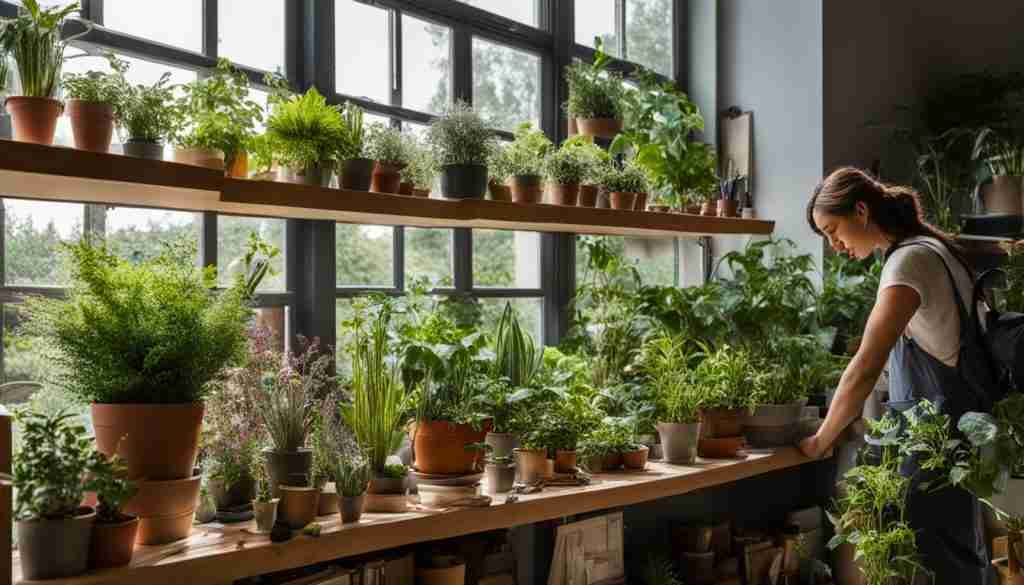
Expert Quote:
“Indoor gardening is a perfect way to experience the joy of nurturing plants and bringing nature into your home. Start with a few easy-to-care-for plants and gradually expand your collection. Before you know it, you’ll have a vibrant indoor garden that adds beauty and improves air quality.” – Jennifer Green, Horticulture Specialist
Creating a Stylish Indoor Garden
Indoor gardening not only improves air quality but also adds a touch of beauty to your living space. There are numerous ways to create a stylish indoor garden that reflects your style and enhances your home decor. Here are some ideas to inspire you:
1. Decorative Pots and Planters
Choose pots and planters that not only serve as functional containers but also complement your home decor. Opt for stylish shapes, colors, and materials that match your interior design style. Ceramic, terracotta, and woven baskets can add texture and visual interest to your indoor garden.
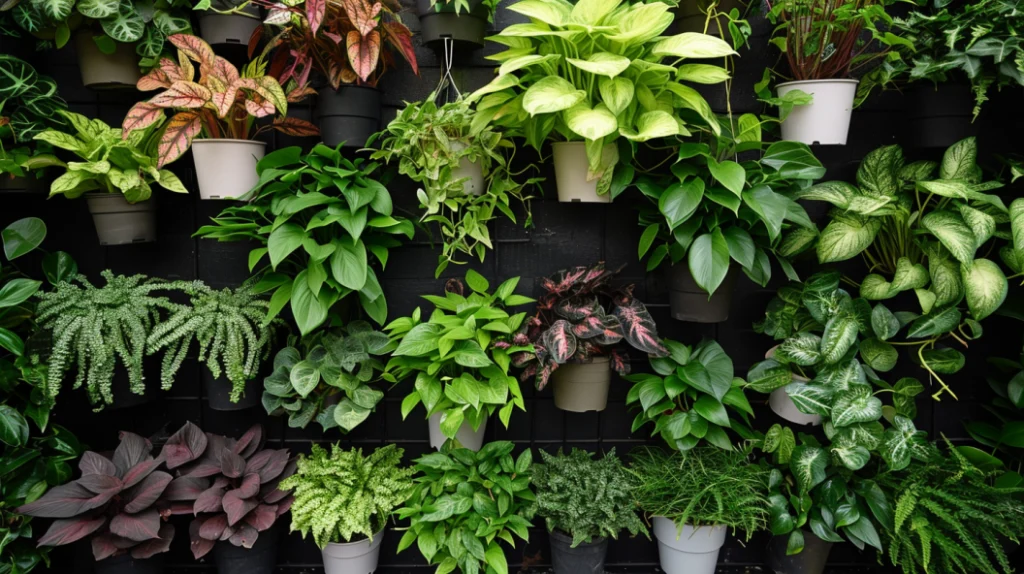
2. Hanging Plants and Vertical Gardens
If you have limited space, consider hanging plants or creating a vertical garden. Hanging plants can be suspended from the ceiling or mounted on walls, adding a touch of greenery to your living area without occupying valuable floor space. Vertical gardens can be created using wall-mounted planters, shelves, or even repurposed pallets.
3. Mix and Match Plant Varieties
Add visual interest to your indoor garden by mixing and matching different plant varieties. Combine plants with varying heights, leaf shapes, and colors to create an eye-catching display. For example, pair tall, slender plants like the Snake Plant with trailing vines like the Devil’s Ivy for an interesting contrast.
4. Low Maintenance Plants
For those with a busy lifestyle or less-than-green thumbs, low-maintenance plants are the perfect choice. Opt for plants that require minimal care and can thrive in various light conditions. Some popular low-maintenance indoor plants include the ZZ Plant, Pothos, and Spider Plant. These plants can tolerate periods of neglect and are perfect for beginners or those who don’t have much time to devote to plant care.
By incorporating these indoor plant decor ideas into your home, you can create a stylish and personalized indoor garden that brings beauty and freshness to your living space.
Incorporate decorative pots and planters that enhance your home decor.
Create hanging plants or vertical gardens to maximize space.
Combine different plant varieties to create interesting textures and colors.
Choose low-maintenance plants that require minimal care and can thrive in various light conditions.
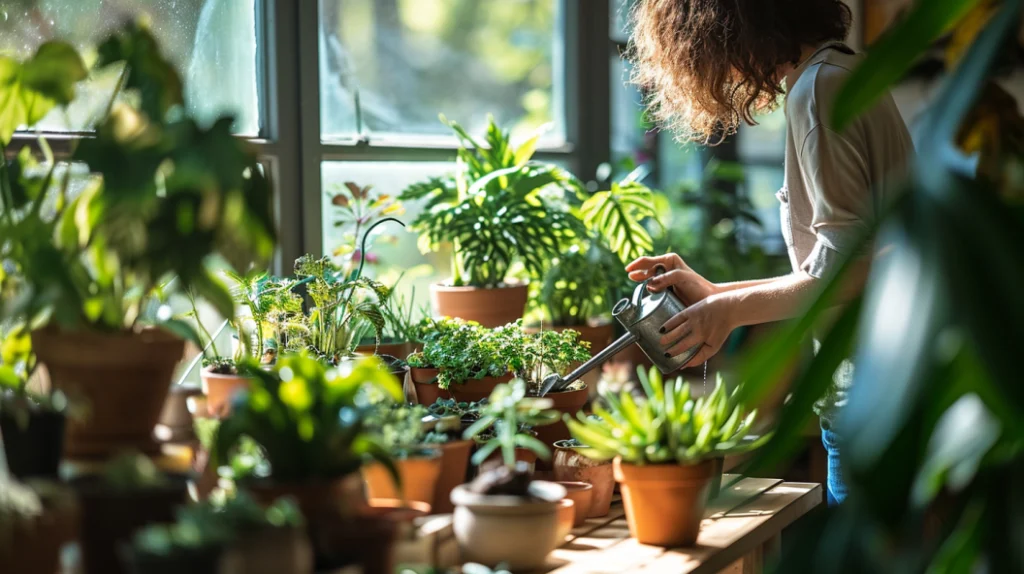
Indoor Plant Care Tips
Proper plant care is essential for the health and growth of your indoor plants. By following these indoor plant care tips, you can ensure that your plants thrive and continue to bring beauty and fresh air into your home.
1. Provide Adequate Light
Different plants have different light requirements, so it’s important to understand their specific needs. Some plants thrive in bright, direct sunlight, while others prefer indirect or low-light conditions. Place your plants in areas where they can receive the appropriate amount of light for their growth. If natural light is limited, consider using artificial grow lights to supplement the light levels.
2. Establish a Regular Watering Routine
Watering your plants regularly and consistently is crucial for their well-being. However, it’s important to understand the watering needs of each plant as overwatering or underwatering can lead to problems. Before watering, check the moisture level of the soil by sticking your finger about an inch deep. If it feels dry, it’s time to water. If it still feels moist, wait a little longer. Avoid letting your plants sit in standing water as it can lead to root rot.
3. Maintain Proper Humidity Levels
Indoor environments can often be dry, especially during winter months when heaters are running. Many plants thrive in humid conditions, so it’s important to monitor and adjust the humidity levels in your home. You can mist your plants with water or group them to create a more humid microclimate. Another option is to use a humidifier, especially if you have a large collection of plants or live in a particularly dry climate.
4. Watch for Pests and Diseases
Pests and diseases can pose a threat to the health of your indoor plants. Regularly inspect your plants for any signs of pests, such as aphids or spider mites. If you notice any pests, take appropriate measures to eliminate them, such as using natural insecticidal soaps or introducing beneficial insects. It’s also important to remove any dead or decaying plant material to prevent the spread of diseases. Regular pruning and fertilizing can help keep your plants healthy and prevent issues.
| Plant Care Tips | Summary |
|---|---|
| Provide Adequate Light | Understand the specific light requirements of your plants and provide them with the appropriate amount of light. |
| Establish a Regular Watering Routine | Water your plants consistently, but avoid overwatering or underwatering by checking the soil moisture levels. |
| Maintain Proper Humidity Levels | Monitor and adjust the humidity levels in your home to ensure that your plants thrive in the ideal conditions. |
| Watch for Pests and Diseases | Regularly inspect your plants for pests and diseases, and take appropriate measures to prevent and treat them. |
By following these indoor plant care tips, you can create a thriving indoor garden and enjoy the beauty and benefits of indoor plants.
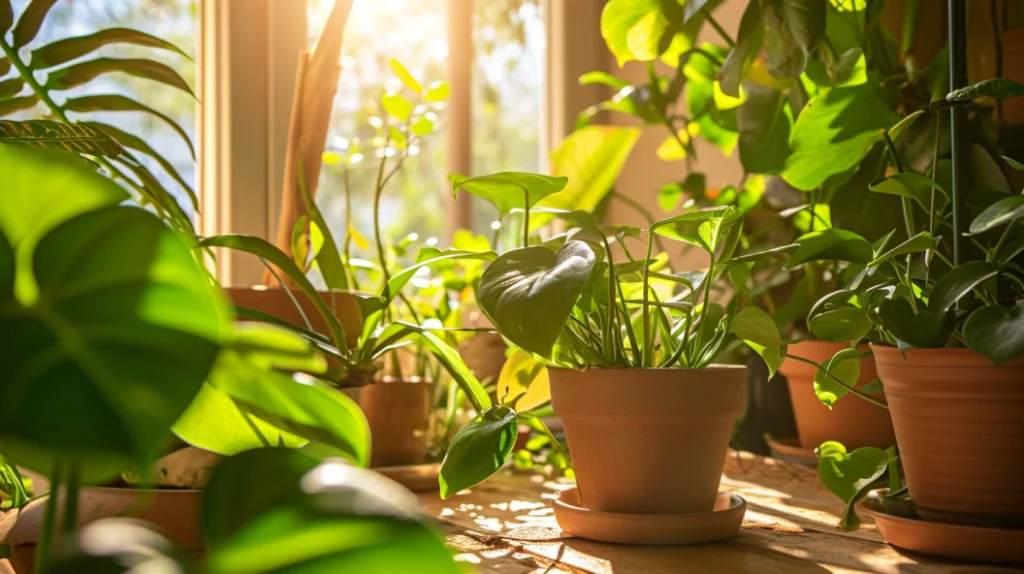
The Best Plants for Indoor Air Quality
Certain plants are particularly effective in improving indoor air quality. According to the NASA Clean Air Study, several air-purifying houseplants excel at removing toxins from the air. By incorporating these plants into your indoor garden, you can create a healthier and cleaner living environment.
Best Plants for Indoor Air Quality:
| Plant | Pollutants Filtered |
|---|---|
| Spider Plant | Formaldehyde, Xylene, Benzene |
| Dracaena | Formaldehyde, Trichloroethylene |
| Snake Plant | Toluene, Formaldehyde, Trichloroethylene |
| Peace Lily | Ammonia, Formaldehyde, Benzene, Trichloroethylene |
| Boston Fern | Formaldehyde, Xylene |
These air-purifying houseplants have been found to effectively filter pollutants such as formaldehyde, benzene, xylene, and trichloroethylene. By reducing the presence of these toxins, you can improve the air quality in your home and enjoy the benefits of cleaner air.
Not only do these plants enhance the aesthetic appeal of your indoor space, but they also contribute to a healthier living environment. By breathing in cleaner air, you may experience improved respiratory health, reduced allergy symptoms, and enhanced overall well-being.
With their ability to filter out toxins, these air-purifying houseplants are an excellent addition to any indoor garden. Incorporate them into your home decor to elevate the look of your living space while reaping the benefits of cleaner air and a healthier environment.
Pet-Friendly Air-Purifying Plants
If you have pets at home, it’s crucial to consider their safety when choosing air-purifying plants. While some common plants like English Ivy and Peace Lily can be toxic to pets if ingested, there are numerous pet-friendly options available that can both enhance the air quality and keep your furry friends safe. Here are a few pet-friendly air-purifying plants to consider:
- Spider Plant: Spider plants are not only safe for pets but also known for their air-purifying properties. They can help remove toxins such as formaldehyde and carbon monoxide from the air.
- Areca Palm: Areca palms are non-toxic to pets and can add a touch of tropical elegance to your indoor space. These plants are excellent for improving air quality and humidity levels.
- Boston Fern: Boston ferns are safe for pets and thrive in humid conditions. They not only help purify the air but also add a lush, green aesthetic to your home.
These pet-friendly air-purifying plants are just a few examples of the many options available. It’s important to research specific plants and consult with your veterinarian to ensure their safety for your particular pets. By incorporating these plants into your indoor garden, you can create a healthier living environment for both you and your beloved animals.
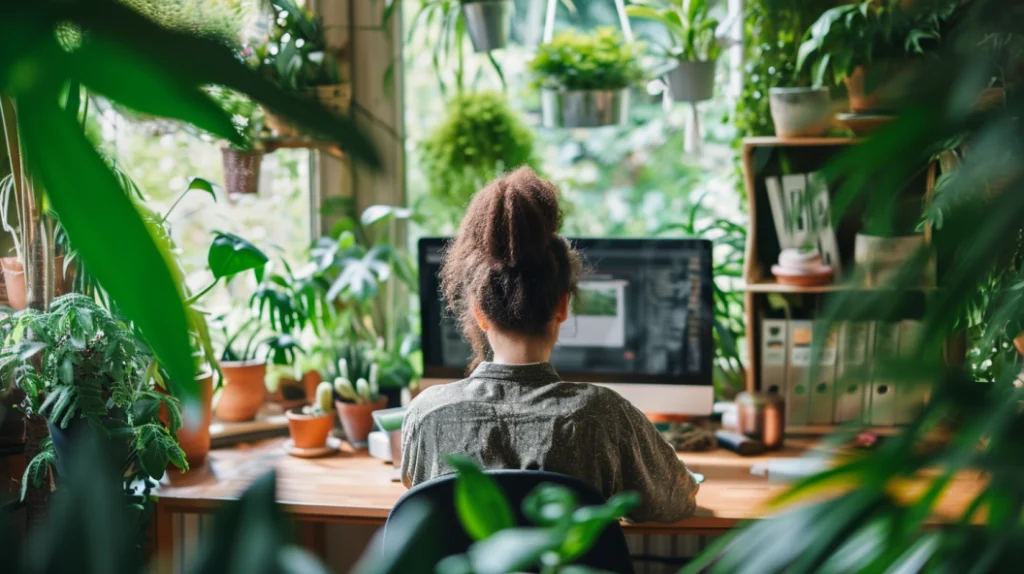
Bringing Indoor Gardening to the Workplace
Indoor gardening is not limited to homes; it can also be incorporated into the workplace to create a healthier and more productive environment. In many office spaces, poor air quality and the absence of natural elements can harm employee well-being and performance. By introducing indoor plants in the office, you can improve the air quality, reduce stress levels, and enhance overall well-being.
Indoor plants have been shown to filter out harmful toxins from the air, such as formaldehyde and benzene, which are commonly found in office furniture and materials. They act as natural air purifiers, creating a fresher and cleaner atmosphere for employees to breathe. This, in turn, can lead to improved cognitive function, increased focus, and decreased sick leave.
Furthermore, plants can contribute to a calming and stress-reducing work environment. Research has shown that the presence of greenery can help reduce stress levels, promote relaxation, and enhance overall mood. This can have a positive impact on employee morale, job satisfaction, and overall productivity.
Studies have found that employees who have access to indoor plants in the workplace experience better well-being, improved job satisfaction, and greater productivity compared to those working in environments devoid of greenery.
Moreover, indoor plants can also boost creativity and problem-solving abilities. The presence of greenery has been found to stimulate the brain and improve cognitive performance. This can be particularly beneficial for tasks that require innovative thinking and outside-the-box solutions.
When incorporating indoor plants in the workplace, it is essential to choose low-maintenance plants that can thrive in the office environment. Consider factors such as available lighting conditions and the office’s pet policies. Opt for plants that require minimal care and can tolerate fluctuations in temperature and humidity.
Benefits of Indoor Plants in the Workplace
| Benefits | Description |
|---|---|
| Better air quality | Indoor plants help filter out toxins and improve air circulation, leading to healthier indoor air quality. |
| Stress reduction | The presence of plants can create a calming and stress-reducing environment, improving overall well-being. |
| Enhanced productivity | Studies have shown that indoor plants can improve focus, creativity, and overall job performance, leading to increased productivity. |
| Improved mood | Greenery in the workplace can positively impact mood, job satisfaction, and overall employee morale. |
By bringing indoor gardening to the workplace, you can not only transform the office environment but also create a space that promotes employee well-being, productivity, and creativity. Sustainable Home Magazine recommends incorporating indoor plants into your office design to elevate both the aesthetics and functionality of the workspace.
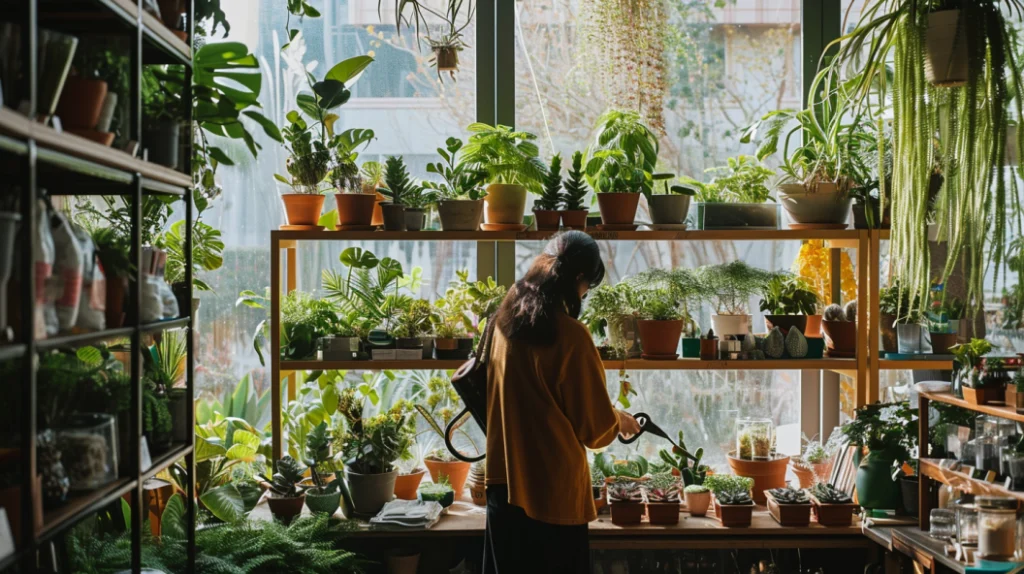
The Impact of Indoor Gardening on Well-Being
Indoor gardening has numerous benefits that go beyond enhancing the aesthetic appeal of your living space. One of the most significant advantages is its positive impact on overall well-being, including mental and physical health. Let’s explore how indoor gardening can transform your living environment and enhance your well-being.
Relaxation and Stress Reduction
Tending to indoor plants can be a therapeutic activity that promotes relaxation and reduces stress. Engaging with nature and greenery has been known to have calming effects on the mind and body. Taking care of your indoor garden gives you a chance to disconnect from daily demands and find tranquility in nurturing living organisms.
“The love for gardening is a seed once sown that never dies.” – Gertrude Jekyll
Mental Health Benefits
Indoor gardening has been associated with improved mental health. The act of caring for plants stimulates positive emotions and provides a sense of purpose and accomplishment. Studies have shown that being surrounded by greenery can reduce anxiety, and depression, and improve overall well-being.
Oxygen Release and Indoor Air Quality
Indoor plants play a crucial role in purifying the air and increasing oxygen levels. Through photosynthesis, plants release oxygen and absorb carbon dioxide. This process helps improve indoor air quality and create a healthier living environment. Breathing in cleaner air can have a positive impact on your respiratory health and overall vitality.
Humidity Regulation
Plants release moisture through transpiration, which helps increase humidity levels in indoor spaces. Adequate humidity is essential for respiratory health, preventing dry skin, and reducing the risk of respiratory infections. By incorporating indoor plants into your living environment, you can create a more comfortable and pleasant atmosphere.
Embrace the power of indoor gardening to prioritize your well-being. With its ability to promote relaxation, reduce stress, improve mental health, purify the air, and regulate humidity levels, indoor gardening offers a holistic approach to creating a healthy and inviting home.
| Benefits of Indoor Gardening | Air Purification | Indoor Air Quality |
|---|---|---|
| Promotes relaxation and stress reduction | Filters out toxins, improving air quality | Increases oxygen levels in the home |
| Enhances mental health and well-being | Reduces the risk of respiratory issues | Regulates and increases humidity levels |
| Creates a sense of purpose and accomplishment | Helps prevent dry skin and respiratory infections |
Final Thoughts
Indoor gardening and air-purifying plants offer a multitude of benefits for your home and well-being. They not only enhance the aesthetic appeal of your living space but also promote cleaner air, reduce stress, and improve overall health.
Whether you’re a beginner or an experienced gardener, there are a wide variety of plants to choose from that can thrive in different light and humidity conditions. By following proper plant care tips and incorporating indoor gardening into your lifestyle, you can create a healthier and more sustainable home.
Start your indoor gardening journey today and elevate your living space. With the help of sustainable home magazines and resources, you can find inspiration and guidance to create a vibrant and green environment. Embrace the beauty of nature indoors and enjoy the numerous benefits of indoor gardening for a healthy home.
FAQ
What are the benefits of indoor gardening and air-purifying plants?
Indoor gardening and air-purifying plants not only enhance the aesthetic appeal of your living space but also improve air quality, reduce stress, and promote overall health.
How do I choose the right air-purifying plants for my indoor garden?
When selecting air-purifying plants, consider factors such as the size of your space, available light conditions, and the level of maintenance you are willing to provide.
What are some indoor gardening tips for beginners?
Beginners can start by choosing plants that suit their available light conditions, providing proper watering and humidity levels, using organic fertilizers, and exploring different plant varieties.
How can I create a stylish indoor garden?
You can create a stylish indoor garden by choosing decorative pots and planters, incorporating hanging plants and vertical gardens, and mixing different plant varieties to create interesting textures and colors.
What are some indoor plant care tips?
Proper indoor plant care includes providing adequate light, establishing a regular watering routine, monitoring humidity levels, keeping an eye out for pests and diseases, and regular pruning and fertilizing.
Which plants are best for indoor air quality?
Spider Plant, Dracaena, Snake Plant, Peace Lily, and Boston Fern are some of the best plants for indoor air quality, as they effectively filter pollutants and toxins from the air.
Are there air-purifying plants that are safe for pets?
Yes, there are pet-friendly air-purifying plants such as Spider Plant, Areca Palm, and Boston Fern that are safe for pets if ingested.
How can indoor gardening benefit the workplace?
Indoor gardening in the workplace can improve air quality, reduce stress levels, increase productivity and creativity, and enhance overall well-being.
What is the impact of indoor gardening on well-being?
Indoor gardening promotes relaxation, reduces stress, improves mental health, and creates a more comfortable and healthier indoor environment through increased oxygen and humidity.

